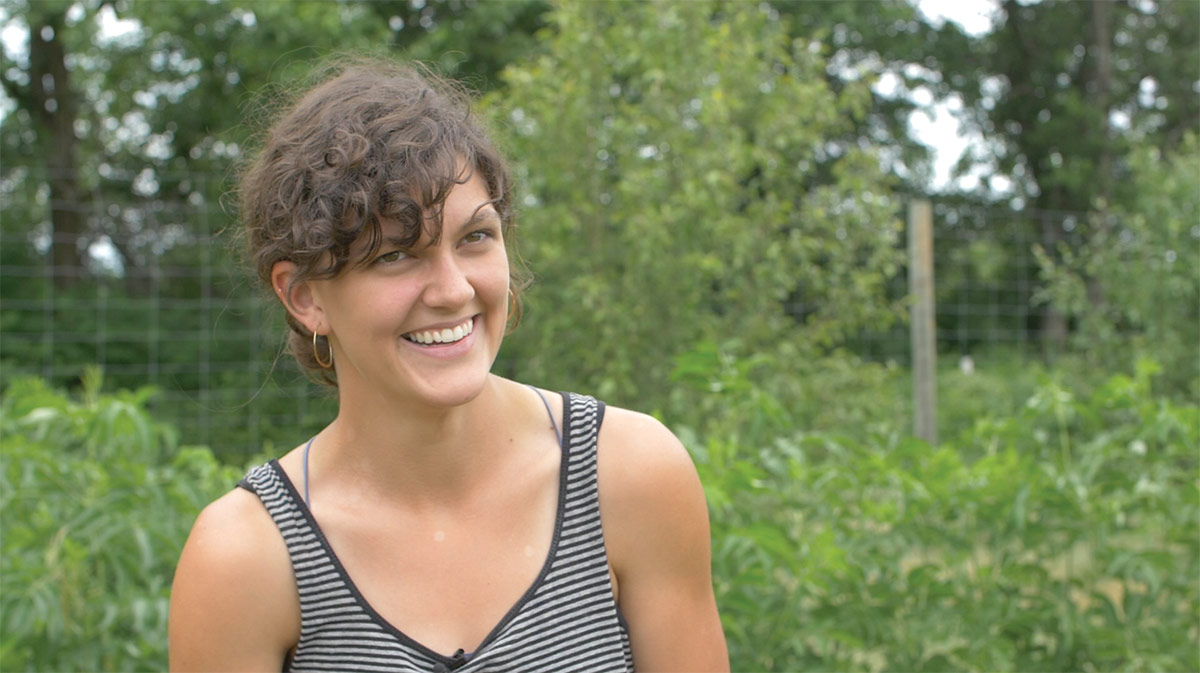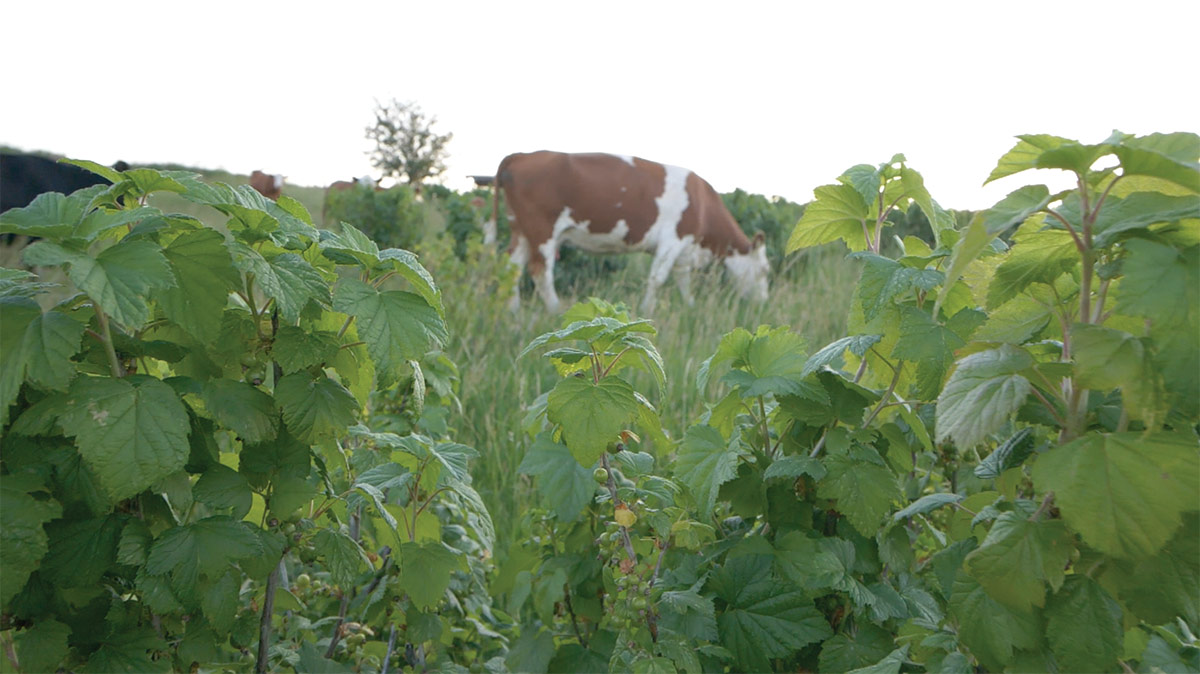Although this year is off to an unusually dry start, it is likely to stand out as an anomaly among the wetter and warmer years that are forecast to come. It’s expected that annual crop fields will flood, perennial crops will bud earlier, and extreme weather will continue to threaten the sustainability of Wisconsin farms, as it did last year. The effects of climate change have arrived in the Midwest, and Wisconsin’s farmers are experiencing them acutely.
When it comes to addressing the changing climate, perennial crops (plants that live more than two years and often for many decades) offer the state a transformative opportunity. With deeper and more extensive roots, perennial crops can absorb more water and bind up more soil and nutrients to help protect against flooding. Perennial tree crops especially are highly efficient at storing carbon, pulling it out of the atmosphere and sinking it into their stems, branches, trunks, and the ground via large root systems in a process called carbon sequestration. As societies move to respond to climate change, multifunctional perennial agriculture systems that incorporate trees are receiving attention and massive investment as one of the globe’s leading natural climate solutions.
Wisconsin farmers have long planted trees on their farms as a conservation practice. Windbreaks of trees on the perimeter of fields, for example, were promoted heavily by the government during the 1930s Dust Bowl years as a way to prevent wind erosion of exposed soil. The USDA’s Natural Resources Conservation Service still provides cost-sharing programs to encourage farmers to adopt agroforestry, a term used to describe farming systems that incorporate trees. The program today goes far beyond windbreaks and riparian buffers along rivers and streams. It now includes alley cropping, which alternates rows of trees or shrubs with rows of annual crops; silvopasture, where trees and shrubs are planted in rows or in a random savanna-like arrangement that allows sunlight to reach the ground layer grasses that provide livestock grazing; and forest farming. All of these are agroforestry practices that Wisconsin farmers and landowners currently use to employ trees as a natural climate solution.

Lily Springs Farm, a 100-acre farm near Osceola in northwest Wisconsin, focuses on regenerative agriculture and grows perennial crops such as elderberries, nuts, and herbs. Lily Springs staff describe their land stewardship as inspired by Indigenous practices, acknowledging the local Dakota, Anishinaabe, and Ho-Chunk who are the First Nations in the area. Elderberries, for example, are tall shrubs native to the region, and humans here have used them as food and medicine for millennia. The benefits of elderberry bushes to the ecosystem are many. They sequester carbon, prevent soil erosion, and provide habitat for pollinators and other wildlife, all while growing nutritious and profitable food for local communities.
Located on the Horse Creek Watershed, Lily Springs Farm plays an important role in filtering water runoff before it feeds into the Greater St. Croix Watershed and the Mississippi River. “Our agricultural practices directly affect the watershed,” says Elle Sullivan, a farm manager at Lily Springs. “We’re part of an interconnected system that requires a lot of attention and care.”
Trees planted along the waterways at Lily Springs create a riparian buffer that acts as a natural flood barrier. The tree root systems hold in soil and capture nutrients before they enter the waterway. The trees’ multiple trunks are physical barriers that slow flow and enable natural levees to form. As Wisconsin prepares for more flooding in the changing climate, agroforestry systems with riparian buffers are critical to increasing the state’s resilience and protecting local freshwater resources. According to a 2020 study, 39 million acres of cropland across the U. S. could be converted into riparian buffers, windbreaks, and alley cropping, which could sequester 71 million tons of carbon annually.
Unfortunately, over the last 25 years, mature windbreaks on many Wisconsin farms have been cut down to make it easier to move mobile overhead sprinkler systems across larger fields. Riparian buffers have been removed to gain additional acres of corn to capitalize on demand for corn-base ethanol. Small dairies have been consolidated into larger operations. Former pastures are now in crops of corn and alfalfa for silage, and cattle are confined and fed silage year round. Reversing these trends and investments may require considerable persuasion.
Wisconsin, however, has several organizations focused on helping landowners make these changes. Lily Springs, for example, has an ongoing partnership to train agricultural apprentices with the Savanna Institute, a Wisconsin-based nonprofit that works to advance agroforestry in the Midwest. Savanna Institute collaborates with farmers and scientists to share knowledge, conduct research, and educate the public about agroforestry practices thereby laying the groundwork for widespread adoption across the region.

Silverwood County Park is a 300-acre Dane County agricultural park near Edgerton, along the Rice Lake shoreline, where the Savanna Institute runs an agroforestry demonstration site. It is one of several sites in the Midwest established by the Savanna Institute to conduct research and educational programming for the public.
Along Silverwood’s field edges, visitors can see windbreaks lined with American plum, poplar, and oak trees, and black currant bushes, which help hold soil and retain moisture, and keep herbicide drift out. In another area of the park, a food forest filled with diverse fruit and nut species becomes a tasting orchard during Silverwood’s community events. At the heart of the park is an alley crop field with alternating rows of chestnut and walnut trees and elderberries growing alongside organic annual crops that local farmer Mark Doudlah plants and harvests each year. Last year he planted sunflowers; he planted soybeans the year before. By allowing multiple crops to be grown on each acre, alley cropping increases biodiversity within farming systems and, according to a 2018 study, has the potential to increase production 200%.
Some might wonder why chestnuts were chosen as a crop at Silverwood. The chestnut is not native to Wisconsin and is better suited to forests of the Appalachian region. In addition, American chestnuts were almost wiped out by a fungal blight years ago, and the species remains highly susceptible. The Savanna Institute is undertaking a program to grow chestnuts that are a cross between the American tree and a Chinese species that is fairly resistant to blight. The Institute is anticipating that by the time the trees are well along in their growth, the climate in Wisconsin will be warmer and wetter, more like the Appalachians where the chestnut once thrived.
Over time, Silverwood visitors will witness the alley crop system changing as the trees mature. In about ten years, the Savanna Institute will plant more shade tolerant annual crops, as the tree canopy expands. By the system’s twentieth year, Silverwood will have mature chestnut and timber trees and potential for silvopasture—a system where some of the trees are harvested for wood, which opens the system to more sunlight, enabling grasses to thrive and livestock to graze on forage among the remaining tree crops.
Alley cropping systems require careful planning, not just for this year or the next but for twenty years down the road. Crops must be selected that are suited to the site’s soil and exposure and that also are compatible with one another. Some plants protect their growing space by releasing chemicals from their leaves or roots that suppress the growth of other species. Some species require more pruning, pest control, or herbicide treatment than others. Calculating correct spacing beween plants is also critical. The transition to silvopasture means that the landowner must be able to deal with livestock or develop a working relationship with someone who is. There are challenges to this system, but it offers exciting possibilities.
Multi-story agroforestry systems like alley cropping have an enormous potential to sequester carbon, according to Project Drawdown, a nonprofit organization that studies climate solutions. Alley cropping creates more options for farmers. Instead of choosing between production or conservation, farmers can achieve both and in the process sequester carbon, diversify farm income, and build resiliency on their land.

The Driftless Area in southwestern Wisconsin is a geological marvel, spanning roughly 24,000 square miles of steep hills, forested ridges, and deeply carved river valleys that were untouched by the glaciers. The geography of the Driftless Area has deeply influenced the ways people have cultivated the region. Its highly productive oak savanna ecosystems have been co-created by human and animal residents over millennia. Today the region is home to a diverse farming community, including a growing number of farmers who practice agroforestry.
Branches and Berries is a second-generation farm near Wauzeka on the lower Wisconsin River, owned and operated by the Peralta family. On about 60 acres, the Peraltas grow red currants, raspberries, aronia berries, and a collection of ornamental plants whose decorative branches are cut for local flower markets. A herd of 25 cows helps mow weeds among the berry rows and fertilize the soil while the berries are budding. This managed grazing system, silvopasture, helps improve soil quality, supports healthy livestock, and increases the farm’s overall productivity and vitality.
“It’s helping a little bit to keep this healthy and green and safe,” Wandy Peralta says, overlooking grazing in the field. “We produce healthy food, with the cows…healthy meat.”
Perhaps more than any other agroforestry practice, silvopasture has the potential to be a major natural climate solution in the Midwest. Growing trees or shrubs and forage in animal pastures could transform Wisconsin’s agricultural landscape and help make it into a carbon sink primed to pull huge amounts of carbon out of the atmosphere. There are 66 million acres of pastureland in the U. S. that are ecologically appropriate for trees, and adopting silvopasture on this land could sequester 87 million tons of carbon annually, the equivalent, according to EPA Greenhouse Gas Equivalencies, of taking over 201 million barrels of oil off the market.
Because of its enormous potential impact, Project Drawdown has ranked silvopasture in its top ten climate change solutions, with the Midwest as a target region for its adoption. Over the last year, Branches and Berries Farm has been working with the Savanna Institute to help other farmers in Wisconsin implement silvopasture on their farms.
Monika Shea is a landscape ecologist and researcher at the Savanna Institute who lives on Wisconsin’s northernmost coast in the floodplains of Lake Superior. In 2016, the area experienced record floods when severe storms dropped up to 10 inches of rain in just 24 hours.
Shea’s research for the Savanna Institute will be critical to the success of perennial agriculture in the Midwest. She is mapping the suitability of different tree and shrub species across the region to help identify the most resilient among them. One of the next steps is to integrate information on climate change scenarios into the suitability mapping process.
“Agroforestry systems are a long-term investment. Chestnut trees, for example, start producing at around three to seven years, and can live 50 to 100 years,” explains Shea. “Planting trees and shrubs in the places best suited for them will help set farmers up for success.”
Back in the Driftless Area, which also experienced record floods in 2018, the Savanna Institute is setting up a farm campus in Spring Green. There, Shea’s colleagues work on breeding tree crops for the Midwest region. They are especially interested in trees and shrubs that have promising market potential. Hazelnuts, for example, are a perennial crop that represent a $7 billion global market that is set to double in the next decade. The Institute’s Spring Green campus includes a commercial-scale hazelnut planting, and staff are connecting hazelnut growers with one another to share equipment, processing facilities, and crop genetics to jumpstart the regional market.
The campus is quickly becoming an incubator for local agribusiness owners who want to help scale-up agroforestry in the Midwest. It recently celebrated the launch of Canopy Farm Management, a business that plants trees and maintains perennial agriculture systems for landowners who may not otherwise have the time or equipment. The Savanna Institute is one of its investors along with Grantham Environmental Trust. A portion of Canopy’s profits go back to the nonprofit to help further its research, education, and outreach mission.
“Everyone has a role to play in addressing climate change, whether you are a nonprofit, a government agency, a farmer, or a business,” says Kevin Wolz, CEO of Canopy. “Climate change is coming for all of us, and we need to find ways to leverage the benefits of each sector to meet the challenge.”
Barbara Decré, a community agroforester at the Savanna Institute, is the contact for people interested in starting an agroforestry system. Originally from France, Decré earned a PhD from UW–Madison and stayed to help grow the Midwest agroforestry movement. She works with Wisconsin farmers and landowners to create long-term, sustainable plans for growing trees. “We talk about values, goals and vision for the land and then create a plan for the next ten, fifteen, and twenty years ahead,” says Decré.

“The great thing about agroforestry is that there are so many benefits…If people want to plant trees to improve soil, or because they are beautiful, or because they want to capture carbon, or for an income opportunity…It doesn’t really matter why they want to plant trees; what is important is that they want to try. We can help them make it possible.”
The Savanna Institute is on a mission to scale-up agroforestry across the Midwest in a big way. In the last year alone, it partnered with 86 farmers and institutional landowners to transition 2,600 acres in the Midwest to agroforestry. By 2025, it hopes to reach 10,000 acres a year. Demonstration farms like Silverwood, educational partnerships like those with Lily Springs and Branches and Berries, and scientific and market research at the Spring Green campus are all part of Savanna Institute’s strategy to transform Midwest agriculture into a natural climate solution.
“Incremental change is no longer enough,” says Keefe Keeley, Executive Director of the Savanna Institute. “Farmers need better economic options, and society needs farmers to be climate heroes. Agroforestry can be a transformative solution that makes it possible to pull a lot of carbon out of the atmosphere and put it to work, making farms more profitable and resilient.”
In a 2020 study, scientists found that around the world, agroforestry could sequester nearly 6 gigatons of carbon equivalent per year—more than twice any other agricultural land management approach.
Curt Meine, a conservation biologist, scholar, author, and Wisconsin Academy Fellow who lives down the road from Savanna Institute’s campus in Spring Green, collaborated with Keefe Keeley on The Driftless Reader, an anthology of writing about the region they both call home. “In Wisconsin agriculture, we’re looking at so many critical challenges,” Meine says. “Fortunately, the Savanna Institute has a positive message to share. It’s going to take a lot of big-heartedness and openness to succeed, but I believe Wisconsin agriculture can be a natural climate solution.”
Most farmers would agree that success in farming depends a great deal on listening to the land and adapting to the conditions. As the climate continues to change, Wisconsin farmers will need to change with it. Agroforestry is a promising and proven natural climate solution for Wisconsin’s future.




